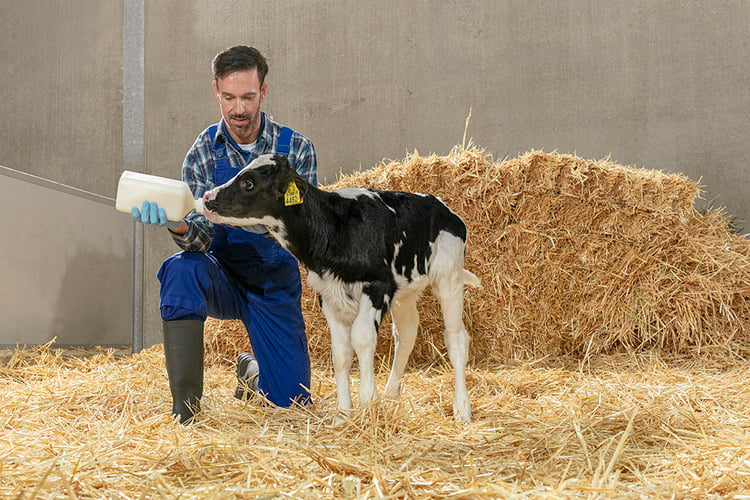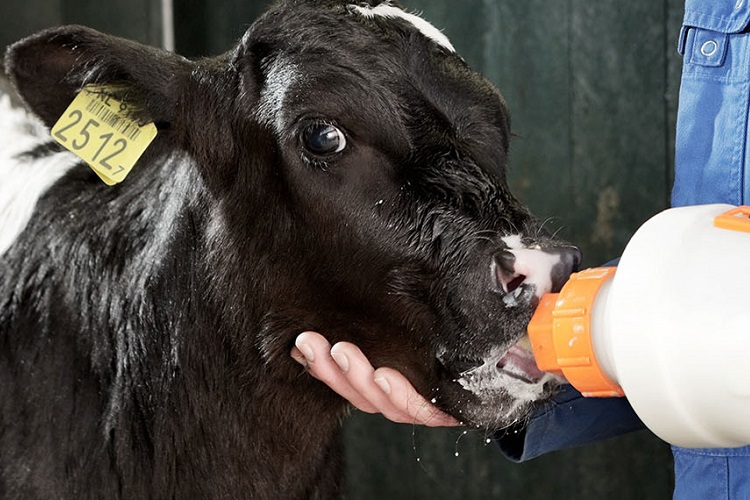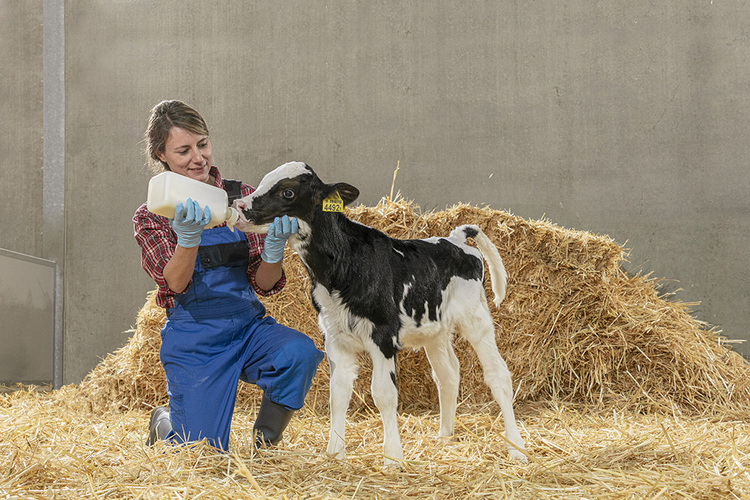- LifeStart
- Colostrum Management
Key takeaways from the research:
-
Measuring colostrum quality with a Brix refractometer is a practical method to measure levels of colostral antibodies
-
Colostrum with a Brix value ≥ 22% should be used
-
Colostrum with a Brix value of < 18% should be discarded
-
If colostrum has a Brix value of ≥ 18% but < 22%, supplementation should be considered

Measuring colostrum quality with a Brix refractometer is a practical method to ensure each calf gets good quality colostrum
IgG is seen as the most reliable indicator of successful transfer of passive immunity to newborn calves. If calves reach a serum IgG level of ≥ 10g/L in a sample obtained between 1 to 7 days after birth, transfer is considered to be successful. To reach this passive immunity level, calves need to be fed at least 3-4 litres of good quality colostrum within 6 hours after birth. Based on the assumption that calves need to receive 100 to 200 g of IgG[1] to ensure they have sufficient immunity against disease, an IgG concentration in cow colostrum of 50 g/L is considered as a cut-off value between good and bad quality colostrum[2,3,4].
A US study on 827 samples in 67 herds showed that almost 30% of colostrum samples had an IgG concentration < 50 g/L[5]. A more recent study carried out in the Netherlands showed similar results: 65% of colostrum samples tested was of good quality, 18% moderate and 17% was of poor quality[6]. It is therefore important for farmers to measure the quality of colostrum they feed to their calves.
The radial immunodiffusion assay (RID), is considered to be the gold standard method for measuring colostral antibodies[7]. Near-Infrared spectrometry (NIRS) can be considered as another gold standard test. Neither of these methods can be used routinely on farms[8,9]. Measurement of specific gravity has been proposed as a way to assess colostrum quality but a major drawback is the fragility of the colostrometer and the need to clean it between measurements. Color assessment has shown not to be reliable enough[10].
A hand-held Brix meter can be used to measure the sugar concentration in a few drops of colostrum. The refractive index converted on a Brix scale can be used to distinguish good quality (IgG ≥ 50 g/L) versus poor quality colostrum (IgG < 50 g/L)[9,11,12]. The results of a meta-analysis of 11 studies in which a Brix refractometer was used under practical conditions is presented in this article[13].
Study design
The results of 11 studies were included in the meta-analysis, resulting in an analysis of 4,251 samples.
Results
Of the total number of colostrum samples the percentage of samples with an IgG level ≥ 50 g/L varied between 67.3% and 92.3%, with a median value of 77.9%, measured by RID (9 studies) or NIRS (2 studies).
If a Brix value of 22% was taken as cut-off point, the sensitivity (ability of the Brix test to identify a sample with IgG ≥ 50g/L as being of good quality) of the Brix test was 80.2% and the specificity (ability of the Brix test to identify a sample with IgG < 50 g/L) was 82.6%. If a Brix value of 18% was taken as the cut-off value, sensitivity increased to 96.1% but specificity decreased to 54.5%. Using this information, it is proposed to use a cut-off value of 22% to select good quality colostrum and to consider storing some of that colostrum as frozen colostrum for other calves. A cut-off value of 18% should be used to discard poor quality colostrum. Colostrum with a value below 18% should therefore not be used. If values are between 18 and 22%, supplementation with colostrum form another dam or with a colostrum product should be considered.
Conclusion
It was concluded that measuring the Brix value with a refractometer is a practical method to test the quality of colostrum on farm. If a value of 22% is taken as cut-off, more than 20% of samples do not have an IgG level of ≥ 50 g/L.
References
[1] McGuirk, S. M., and M. Collins. 2004. Managing the production, storage and delivery of colostrum. Vet. Clin. North Am. Food Anim. Pract. 20:593–603.
[2] Chigerwe, M., and J. V. Hagey. 2014. Refractometer assessment of colostral and serum IgG and milk total solids concentrations in dairy cattle. BMC Vet. Res. 10:178.
[3] Chigerwe, M., J. W. Tyler, J. R. Middleton, J. N. Spain, J. S. Dill, and B. J. Steevens. 2008. Comparison of four methods to assess colostral IgG concentration in dairy cows. J. Am. Vet. Med. Assoc. 233:761–766.
[4] Godden, S. 2008. Colostrum management for dairy calves. Vet. Clin. North Am. Food Anim. Pract. 24:19–39.
[5] Morrill, K. M., E. Conrad, A. Lago, J. Campbell, J. Quigley, and H. Tyler. 2012. Nationwide evaluation of quality and composition of colostrum on dairy farms in the United States. J. Dairy Sci. 95:3997–4005.
[6] Van der Gaast, E, personal communication.
[7] Fleenor, W. A., and G. H. Stott. 1981. Single radial immunodiffusion analysis for quantitation of colostral immunoglobulin concentration. J. Dairy Sci. 64:740–747.
[8] Rivero, M. J., X. Valderrama, D. Haines, and D. Alomar. 2012. Prediction of immunoglobulin G content in bovine colostrum by near infrared spectroscopy. J. Dairy Sci. 95:1410–1418.
[9] Bartier, A. L., M. C. Windeyer, and L. Doepel. 2015. Evaluation of on-farm tools for colostrum quality measurement. J. Dairy Sci. 98:1878–1884.
[10] Gross, J. J., E. C. Kessler, and R. M. Bruckmaier. 2014. Colour measurement of colostrum for estimation of colostral IgG and colostrum composition in dairy cows. J. Dairy Res. 81:440–444.
[11] Bielmann, V., J. Gillan, N. R. Perkins, A. L. Skidmore, S. Godden, and K. E. Leslie. 2010. An evaluation of Brix refractometry instruments for measurement of colostrum quality in dairy cattle. J. Dairy Sci. 93:3713–3721.
[12] Quigley, J. D., A. Lago, C. Chapman, P. Erickson, and J. Polo. 2013. Evaluation of the Brix refractometer to estimate immunoglobulin G concentration in bovine colostrum. J. Dairy Sci. 96:1148–1155.
[13] Buczinski, S, and J. M. Vandeweerd. 2016. Diagnostic accuracy of refractometry for assessing bovine colostrum quality: A systematic review and meta-analysis. J. Dairy Sci. 99:7381–7394.



